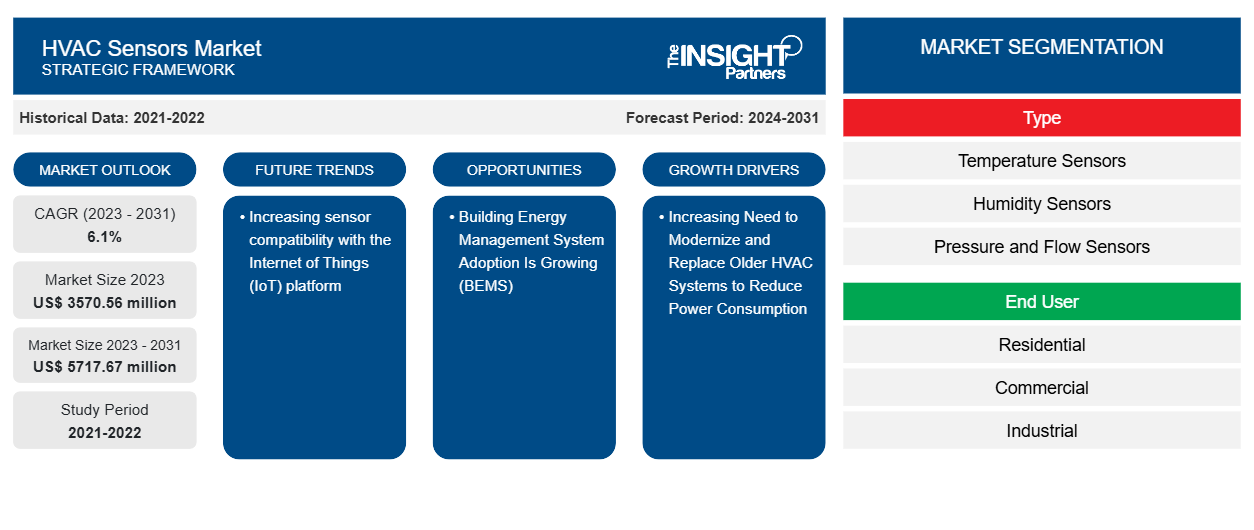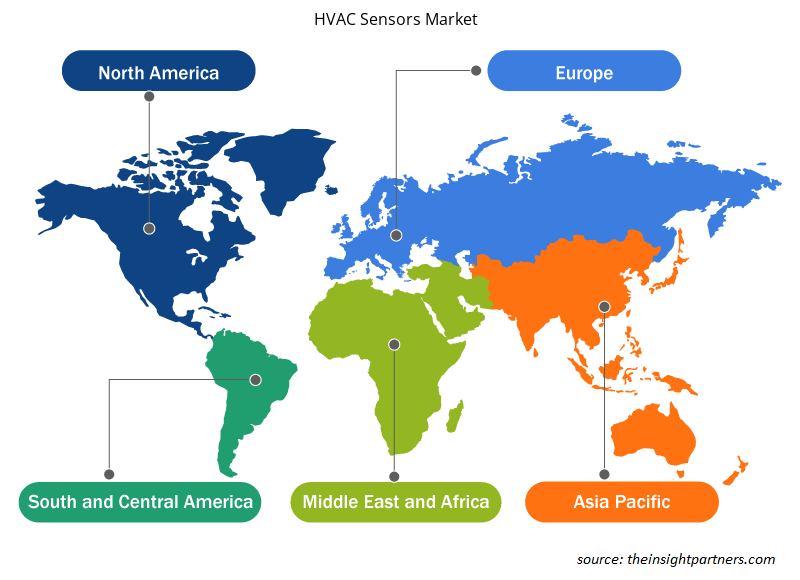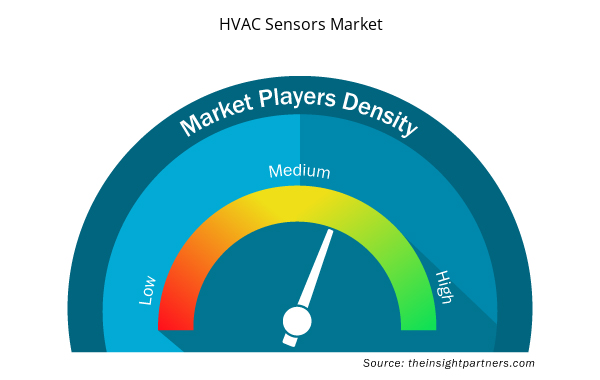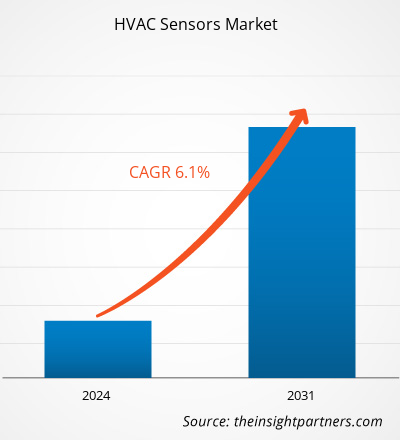The HVAC sensors market size is projected to reach US$ 5717.67 million by 2031 from US$ 3570.56 million in 2023. The market is expected to register a CAGR of 6.1% in 2023–2031.
The increasing sensor compatibility with the Internet of Things (IoT) platform is likely to remain a key HVAC sensors market trend.
HVAC Sensors Market Analysis
The HVAC sensor market was utilized by several industries, such as commercial, residential, automobile, and others. Nowadays, there is fierce competition in the business world because leading organizations must prioritize environmental preservation, productivity, quality, safety, and safety. Over the past few years, HVAC systems have been used extensively in many programs all over the world. Numerous sensors, including pressure and temperature sensors, among others, find a use that makes them possible. HVAC systems provide good air quality and thermal comfort for both car and room interiors. The HVAC sensors are used to address the needs of various end users who are concerned about energy efficiency. They assist in providing properly maintained interior spaces with low power usage.
HVAC Sensors Market Overview
HVAC systems are frequently utilized to maintain, control, and thereby lower energy usage. An audio device that mimics a real condition, such as temperature or the target world, is included in the frequency. The most significant kind of HVAC sensor helps to keep the proper temperature and modify the needed temperature by differentiating the input temperature from the building or room temperature. For end users including industrial, residential, and commercial buildings, HVAC sensors can manage, control, and monitor various operations like air pressure, temperature, and quality. As a result, HVAC sensors are becoming increasingly commonplace due to the necessity to save energy.
Customize This Report To Suit Your Requirement
You will get customization on any report - free of charge - including parts of this report, or country-level analysis, Excel Data pack, as well as avail great offers and discounts for start-ups & universities
HVAC Sensors Market: Strategic Insights

- Get Top Key Market Trends of this report.This FREE sample will include data analysis, ranging from market trends to estimates and forecasts.
Customize This Report To Suit Your Requirement
You will get customization on any report - free of charge - including parts of this report, or country-level analysis, Excel Data pack, as well as avail great offers and discounts for start-ups & universities
HVAC Sensors Market: Strategic Insights

- Get Top Key Market Trends of this report.This FREE sample will include data analysis, ranging from market trends to estimates and forecasts.
HVAC Sensors Market Drivers and Opportunities
Increasing Need to Modernize and Replace Older HVAC Systems to Reduce Power Consumption
The World Economic Forum estimates that buildings are responsible for over 40% of energy-related carbon dioxide emissions and nearly a third of global energy consumption. About one-third of those emissions, according to the World Green Building Council, are caused by the energy needed for a building's operations, which include heating, cooling, and powering the structure. According to Iota Communications, the average office building spends about $30,000 a year on electricity. In a commercial structure, HVAC systems frequently use the most energy. According to estimates from the U.S. Department of Energy, HVAC systems normally account for 35% of a building's energy use. The need for HVAC systems with air filtration characteristics increased during the pandemic. Updated ventilation systems serve a crucial public health purpose by filtering the air and lowering airborne pollutants, such as virus-containing particles.
Building Energy Management System Adoption Is Growing (BEMS)
Buildings cannot function without HVAC systems despite their exorbitant expense. The Australian Department of Climate Change, Energy, the Environment and Water estimates that the average HVAC system uses about 40% of the building's overall energy consumption and 70% of its base energy use. The computer-based automated systems known as Building Energy Management Systems (BEMS) keep an eye on and regulate every energy-related system in buildings, including mechanical and electrical equipment. By enabling precise and automated control of energy systems and supply, energy management shields companies against needless energy spending. A company can reduce its present energy usage by up to 10% to 30% with the aid of BEMS, claims Radiocrafts. As a result of the due to conflict between Russia and Ukraine, energy prices are skyrocketing in the EU. Thus, the building energy management system Adoption (BEMS) is anticipated to present new opportunities for the HVAC players during the forecast period.
HVAC Report Segmentation Analysis
Key segments that contributed to the derivation of the HVAC analysis are type and end users.
- Based on the type, the HVAC is segmented into temperature sensors, humidity sensors, pressure & flow sensors, motion sensors, smoke & gas sensors, and others. The temperature sensors segment held a larger market share in 2023.
Based on the end user, the HVAC sensors market is segmented into residential, commercial, and industrial.
HVAC Sensors Market Share Analysis by Geography
The geographic scope of the HVAC sensors market report is mainly divided into five regions: North America, Asia Pacific, Europe, Middle East & Africa, and South America/South & Central America. Due to a huge number of contemporary, well-developed infrastructure, including commercial buildings, industrial facilities, and residential properties, North America has the biggest market share for HVAC sensors and controllers. There is a sizable market for HVAC sensors and controllers due to the abundance of buildings with complex HVAC systems.
HVAC Sensors Market Regional Insights
The regional trends and factors influencing the HVAC Sensors Market throughout the forecast period have been thoroughly explained by the analysts at Insight Partners. This section also discusses HVAC Sensors Market segments and geography across North America, Europe, Asia Pacific, Middle East and Africa, and South and Central America.

- Get the Regional Specific Data for HVAC Sensors Market
HVAC Sensors Market Report Scope
| Report Attribute | Details |
|---|---|
| Market size in 2023 | US$ 3570.56 million |
| Market Size by 2031 | US$ 5717.67 million |
| Global CAGR (2023 - 2031) | 6.1% |
| Historical Data | 2021-2022 |
| Forecast period | 2024-2031 |
| Segments Covered |
By Type
|
| Regions and Countries Covered | North America
|
| Market leaders and key company profiles |
HVAC Sensors Market Players Density: Understanding Its Impact on Business Dynamics
The HVAC Sensors Market market is growing rapidly, driven by increasing end-user demand due to factors such as evolving consumer preferences, technological advancements, and greater awareness of the product's benefits. As demand rises, businesses are expanding their offerings, innovating to meet consumer needs, and capitalizing on emerging trends, which further fuels market growth.
Market players density refers to the distribution of firms or companies operating within a particular market or industry. It indicates how many competitors (market players) are present in a given market space relative to its size or total market value.
Major Companies operating in the HVAC Sensors Market are:
- Siemens AG
- Emerson Electric Co.
- Honeywell International Inc.
- Johnson Controls, Inc.
- Schneider Electric
- TE Connectivity Ltd.
Disclaimer: The companies listed above are not ranked in any particular order.

- Get the HVAC Sensors Market top key players overview
HVAC Sensors Market News and Recent Developments
The HVAC sensors market is evaluated by gathering qualitative and quantitative data post primary and secondary research, which includes important corporate publications, association data, and databases. The following is a list of developments in the market for speech and language disorders and strategies:
- In October 2023, Sensata Technologies announced the launch of the Sensata Resonix RGD sensor, the first leak detection sensor with UL certification for multiple A2L refrigerant gases used in heating, ventilation, and air conditioning (HVAC) equipment. The new leak detection sensors support HVAC manufacturers’ transition to refrigerants with a lower global warming impact. (Source: Sensata Technologies, Press Release)
- In January 2023, Third Reality Launched a Temperature and Humidity Sensor. (Source: Third Reality, Press Release)
HVAC Sensors Market Report Coverage and Deliverables
The “HVAC Sensors Market Size and Forecast (2021–2031)” report provides a detailed analysis of the market covering below areas:
- Market size and forecast at global, regional, and country levels for all the key market segments covered under the scope
- Market dynamics such as drivers, restraints, and key opportunities
- Key future trends
- Detailed PEST/Porter’s Five Forces and SWOT analysis
- Global and regional market analysis covering key market trends, major players, regulations, and recent market developments
- Industry landscape and competition analysis covering market concentration, heat map analysis, prominent players, and recent developments
- Detailed company profiles
- Historical Analysis (2 Years), Base Year, Forecast (7 Years) with CAGR
- PEST and SWOT Analysis
- Market Size Value / Volume - Global, Regional, Country
- Industry and Competitive Landscape
- Excel Dataset


- Enteral Nutrition Market
- Educational Furniture Market
- Adaptive Traffic Control System Market
- Volumetric Video Market
- Small Molecule Drug Discovery Market
- Ceramic Injection Molding Market
- Rare Neurological Disease Treatment Market
- Equipment Rental Software Market
- Greens Powder Market
- Medical Second Opinion Market

Report Coverage
Revenue forecast, Company Analysis, Industry landscape, Growth factors, and Trends

Segment Covered
Type and End User

Regional Scope
North America, Europe, Asia Pacific, Middle East & Africa, South & Central America

Country Scope
Argentina, Australia, Brazil, Canada, China, France, Germany, India, Italy, Japan, Mexico, Russian Federation, Saudi Arabia, South Africa, South Korea, United Arab Emirates, United Kingdom, United States
Frequently Asked Questions
The increasing need to modernize and replace older HVAC systems to reduce power consumption and the growing building energy management system adoption are the major factors that propel the global HVAC sensors market.
The global HVAC sensors market was estimated to be US$ 3570.56 million in 2023 and is expected to grow at a CAGR of 6.1 % during the forecast period 2023 - 2031.
Increasing sensor compatibility with the Internet of Things (IoT) platform is anticipated to play a significant role in the global HVAC sensors market in the coming years.
The key players holding majority shares in the global HVAC sensors market are Siemens AG, Emerson Electric Co., Honeywell International Inc., Johnson Controls, Inc., and Schneider Electric.
The global HVAC sensors market is expected to reach US$ 5717.67 million by 2031.

 Get Free Sample For
Get Free Sample For